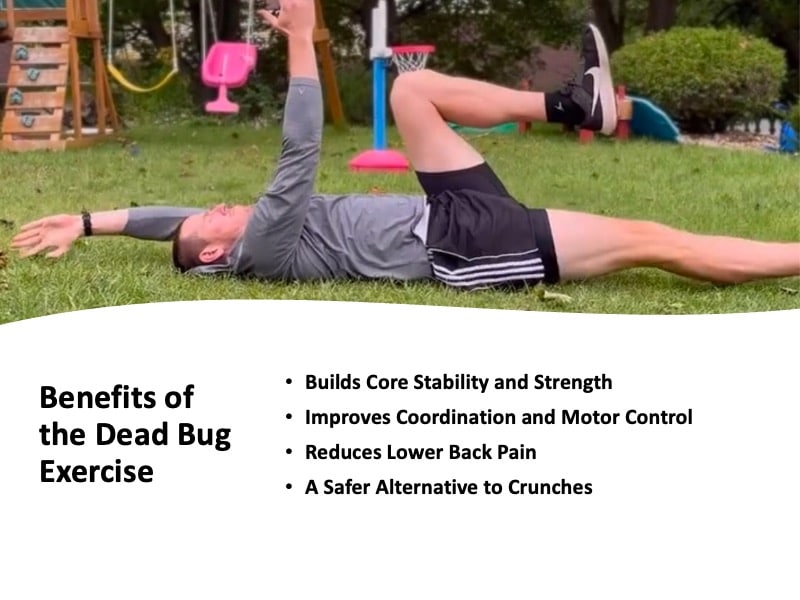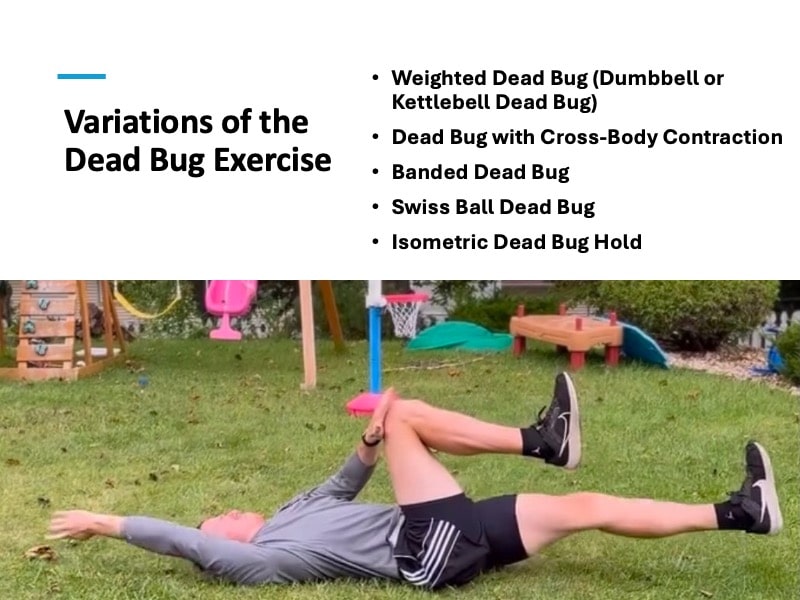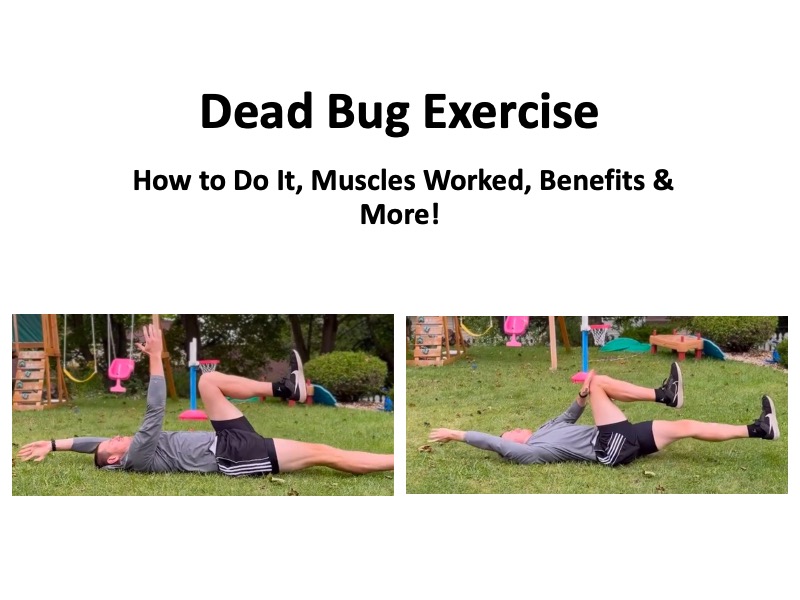Dead Bug Exercise: How to Do, Muscles Worked, Benefits & More!
A strong core is essential for athletic performance, injury prevention, and everyday movement.
The dead bug exercise is one of the most effective ways to build core stability without placing excessive strain on the spine.
Unlike traditional crunches, which primarily target the rectus abdominis, the dead bug exercise engages deep core muscles like the transversus abdominis, internal obliques, and lumbar multifidus, helping to create a well-rounded and functional midsection.
Whether your goal is to develop six-pack abs, improve posture, or enhance overall strength, this dynamic movement offers a safer and more efficient alternative to crunches and situps.
Incorporating dead bug variations—such as weighted, banded, or cross-body contractions—can further amplify core engagement, making them a must-have in any workout routine.
What Is the Dead Bug Exercise?
The dead bug exercise is a foundational core movement that improves stability, strengthens deep abdominal muscles, and develops coordination.
It involves lying on your back with arms and legs extended, then moving opposite limbs simultaneously while keeping the core engaged and the lower back pressed into the floor.
This movement pattern mimics functional activities like walking and running, making it an excellent addition to any fitness regimen.
How to Do the Dead Bug Exercise Correctly
Check out this video below for a quick example of how to do the dead bug exercise and then one simple variation to increase the difficulty.
Tip: Subscribe to my YouTube channel for more exercise demonstrations, unique ideas to help you add variety to your workouts, and new moves to improve your body!
Here is an explanation of how to do the basic version of the deadbug exercise:
- Lie on your back with your arms extended above your shoulders and knees bent at 90 degrees.
- Engage your core and press your lower back into the floor.
- Slowly extend one arm and the opposite leg while keeping the core braced.
- Return to the starting position and repeat on the other side.
- Perform 3 sets of 10-15 reps per side.
Muscles Worked in the Dead Bug Exercise
- Primary Muscles: Transversus abdominis, internal obliques, rectus abdominis, lumbar multifidus
- Secondary Muscles: Hip flexors, glutes, deltoids, and erector spinae
Why the Dead Bug Exercise Is One of the Best Exercises for Six-Pack Abs
The dead bug engages the rectus abdominis—the primary muscle responsible for the “six-pack” look—without putting excessive strain on the spine.
Additionally, it recruits the transversus abdominis, which acts like a corset to cinch the waist and create a defined midsection.
Unlike static exercises like forearm planks, dead bugs promote dynamic core engagement, improving both muscle tone and endurance.
Benefits of the Dead Bug Exercise

The dead bug exercise offers far more than just core activation—it develops core stability, improves coordination, and strengthens deep abdominal muscles without putting strain on the lower back.
Unlike traditional crunches and situps, this movement engages the entire core, making it an excellent choice for athletes, fitness enthusiasts, and anyone looking to build functional strength.
Here’s why some more information on the benefits of the dead bug exercise and why it deserves a place in your workout routine.
Builds Core Stability and Strength
The dead bug exercise primarily targets the transversus abdominis (TrA), internal obliques (IO), rectus abdominis (RA), and lumbar multifidus (LM), providing a strong foundation for movement and injury prevention (Tsartsapakis et al., 2024).
Unlike traditional crunches, which can strain the lower back, dead bugs engage deep core muscles without excessive spinal flexion.
Improves Coordination and Motor Control
By coordinating opposite limbs, the dead bug exercise enhances neuromuscular control, helping athletes and fitness enthusiasts develop better movement patterns.
Reduces Lower Back Pain
Studies suggest that core stability exercises like the dead bug improve lumbar support and alleviate lower back discomfort by engaging stabilizing muscles effectively (Kim et al., 2016).
A Safer Alternative to Crunches
Crunches and sit-ups can stress the spine and hip flexors, increasing the risk of discomfort and injury. Research indicates that dead bugs activate the core more efficiently without causing undue stress on the lower back (Ikele et al., 2020).
How Often Should You Do Dead Bugs?
The dead bug exercise can be performed daily as part of a warm-up routine or included 2-4 times per week as a primary core workout. How you incorporate it depends on your goals and overall training plan.
Using Dead Bugs as a Warm-Up
Performing dead bugs at the beginning of a workout helps activate the deep core muscles and reinforce proper movement patterns.
Since the exercise promotes spinal stability and neuromuscular control, it’s an excellent pre-workout primer before strength training, running, or athletic movements.
- Warm-up protocol: 2-3 sets of 10 reps per side at a controlled tempo.
- Focus: Engaging the core, pressing the lower back into the floor, and maintaining smooth, controlled movements.
Using Dead Bug Variations in a Workout
To build core strength and endurance, incorporate challenging dead bug variations as a main part of your core workout 2-4 times per week.
This can be done at the end of a session as a core finisher or within a full-body workout to improve overall stability.
- Weighted Dead Bug (Dumbbells or Kettlebells): 3 sets of 8-12 reps per side for increased resistance.
- Banded Dead Bug: 3 sets of 10 reps per side to challenge core engagement and coordination.
- Cross-Body Dead Bug: 3 sets of 12 reps per side for enhanced anti-rotational stability.
- Slow Tempo or Isometric Hold Dead Bug: 3 sets of 6-8 reps per side with 3-5 second holds for increased time under tension.
Variations of the Dead Bug Exercise

Adding variations to the dead bug exercise can increase core engagement, challenge stability, and keep your workouts dynamic.
Whether you’re looking to add resistance, enhance coordination, or target different muscle groups, these modifications can help you maximize results.
Try these deadbug variations to take your core training to the next level.
Weighted Dead Bug (Dumbbell or Kettlebell Dead Bug)
Weighted dumbbell or kettlebell deadbugs are a great way to make this exercise more challenging.
Hold a dumbbell or kettlebell over your chest while performing the movement to engage the shoulders and core further.
Dead Bug with Cross-Body Contraction
This variation involves pressing the non-working hand against the knee of the non-working leg, increasing tension in the core and reinforcing cross-body stabilization.
Banded Dead Bug
There are two different types of banded dead bugs- the mini band dead bug and the resistance band dead bug.
- Mini Band Dead Bug: Place a mini resistance band around your feet to activate the hip flexors and core more intensely.
- Resistance Band Dead Bug: Attach a resistance band to a pole or anchor behind you, holding it with both hands over your chest. This adds resistance to the movement and increases muscle activation.
Swiss Ball Dead Bug
Holding a Swiss ball between your hands and knees creates additional engagement in the core, making it harder to maintain stability.
Isometric Dead Bug Hold
Instead of moving your limbs, hold the extended position for 10-15 seconds per rep to build endurance and strength.
Final Thoughts: Is the Dead Bug a Good Exercise?
The dead bug exercise is one of the best core movements for building stability, strength, and coordination while minimizing strain on the spine.
Unlike traditional crunches, dead bugs effectively engage deep core muscles, making them safer and more functional options for athletes and fitness enthusiasts alike.
Whether your goal is to develop six-pack abs, improve posture, or enhance athletic performance, incorporating dead bug variations into your routine can provide long-term benefits.
With its versatility and effectiveness, the dead bug is a must-have in any well-rounded core training program.
This website does not provide medical advice. This website site does contain affiliate links, and purchases may earn a commission.
Read my Medical Disclaimer, Review Disclaimer, and Publishing Policies for more details. Use of this site indicates acceptance of these terms.



